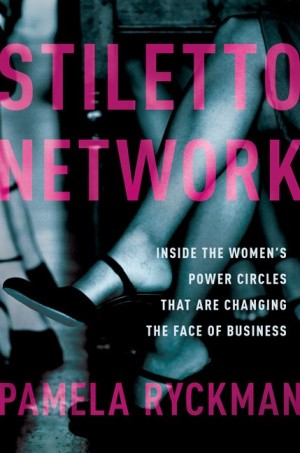
 11 Ways To Create Your Own Stiletto Network
11 Ways To Create Your Own Stiletto NetworkStiletto Networks are already changing the world. A movement has begun, but the purpose of this book is not just to identify it. It’s to catalyze it as well. Why shouldn’t more women back each other like the Indians of TiE? Why shouldn’t they be angling to make their companies and schools and communities and cities and countries better for themselves and others? Why shouldn’t they be banding together and tipping the scales?
Each Stiletto Network is as unique as the women it convenes, but they do have common characteristics. Their stories provide lessons and tips to help others forge their own groups.
It doesn’t matter if you’re a public company CEO, an entrepreneur, a middle manager, a freelancer, a stay-at-home mom, or a college student. You don’t need to be famous or fabulous to create a Stiletto Network, and you need not begin with major connections. In fact, the earlier women get started, the tighter and stronger their groups become. Just as Kathi Lutton said (in Chapter 5), college students can create networks overnight by assembling friends and organizing events for accomplished female alumnae. And, as Mallun Yen (Chapter 2) and Sukhinder Singh Cassidy (Chapter 5) described, when women unite early in their careers, they’re more likely to steer each other toward promotions and opportunities, counsel each other through difficulties, and ultimately become powerful — together.
Stiletto Networks aren’t cabals of best buddies. In fact, they shouldn’t be. And they can’t be simply stocked with employees from the same firm. While there’s no singular formula, the most effective groups draw women with diverse skills from across a variety of industries. They introduce women who might not otherwise meet. They keep members’ thinking fresh, expand their horizons, and increase their spheres of influence.
Still, for Stiletto Networks to gel, women should have some shared traits. For instance, The Vault, 4C2B, Babes in Boyland, and Lady Business each connect women from different industries, but members of each group are about the same age or level of expertise. Similar experiences and touch points allow women to quickly build the bonds of trust and loyalty at the heart of these networks.
Stiletto Networks don’t need a specific goal or agenda at the onset, and as Gerry Laybourne said (Chapter 8), they shouldn’t try to “right the wrongs of oppression.” They need only bring together women with shared values and ethics, women who are open to aiding others. If you get dynamic ladies talking or walking or drinking, exciting things will happen.
We’ve all been to book groups where ladies drink wine, chat about friends and family, and then . . . Oops! Time’s up and no one’s discussed the book. And we’ve all been to networking events where humanity is lost, where we feel surrounded by cardboard cutouts. Stiletto Networks must be purposeful, yet not feel like another work function. They must address the needs of women present, yet still retain the fun. One way to do this is to appoint a different woman to lead each meeting, or like The Vault, to feature guest speakers and establish discussion topics in advance.
Stiletto Networks push members to pursue their passions and take risks. Members should help each woman script difficult conversations (e.g., about promotion or compensation), and shouldn’t be afraid to disagree. Just like Gerry Laybourne was grateful when Maggie Wilderotter “walked [her] to the woodshed” (Chapter 8), and just as Jillian Manus said of her Broad Squad (Chapter 10), we all need friends who tell us hard truths. Speak up when members of your Stiletto Network are making bad decisions or undermining themselves, but do it with kindness.
2012 may have been “The Year of the Woman,” but according to the 4th Estate, a project run by the media monitoring service Global News Intelligence, women were notably underrepresented in coverage of the 2012 presidential election, generally comprising less than 20 percent of sources quoted in the mainstream media. Stiletto Networks can change those statistics. These groups spur women to become visible leaders through a conscious commitment to raising profiles and making their voices heard. They should ensure that each woman establishes herself as an expert, lands speaking engagements, and gets media coverage for her endeavors.
Continue the conversation after you’ve left dinner and gone back to your offices. Keep thinking and communicating. Make it a regular habit to e-mail articles or data that could be of interest to your coterie. Create private LinkedIn groups to further discussion, follow each other and retweet posts on Twitter, and Like and Share each other’s Facebook comments. This idea exchange should become part of everyday life.
Women have trouble asking for help. They don’t want to appear weak or step on toes. Many groups — like Belizean Grove, Carole Hyatt’s Leadership Forum, and now the “Alley to the Valley” series of conferences — have discovered that making “asks and offers” part of a standard process helps members overcome their fear or hesitation. But members should always try to give more than they take.
As Barbara Colwell, the Belizean Grover, said, women don’t really get to know each other at lunch. It’s hard to foster real and true relationships when pulled in many directions. Some of the most cohesive Stiletto Networks — like Belizean Grove or Silvia Fernandez’s venture capital gals — plan an annual getaway. There, members relax and let loose, solidifying and deepening friendships.
It’s nice to be pro-women, and it’s great to help advance qualified girlfriends. But no one works in a vacuum. The best way to change “the comfort formula” is by making introductions and investments with guys too. So think about how to build personal and political capital with men, and incorporate them into your lives and ventures. Integration, not isolation, is the goal.
The above is an excerpt from the book Stiletto Network: Inside the Women’s Power Circles That Are Changing the Face of Business by Pamela Ryckman. The above excerpt is a digitally scanned reproduction of text from print. Although this excerpt has been proofread, occasional errors may appear due to the scanning process. Please refer to the finished book for accuracy.
Copyright © 2013 Pamela Ryckman, author of Stiletto Network: Inside the Women’s Power Circles That Are Changing the Face of Business